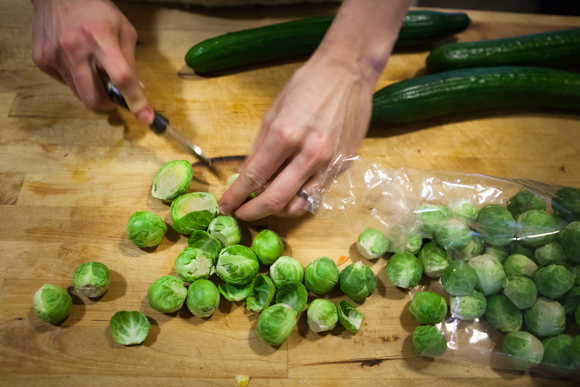A local chef is aiming to change the way D.C. kids eat, one butchered chicken at a time.
Thirty percent of children in the District live in poverty as of the 2011 census, and the overall poverty rate for the city is 18.7%. More than 135,000 D.C. residents were on the Supplemental Nutrition Assistance Program (food stamps) that same year.
Recent studies have also shown that 49% of all SNAP participants are children (age 18 or younger), with almost two-thirds of SNAP children living in single-parent households. In total, 76% of SNAP benefits go towards households with children.
Allison Sosna, 27, knows all that. So the former D.C. Central Kitchen chef launched MicroGreens in Sept. 2012, with the goal to teach 10 low-income sixth- and seventh-graders in a school kitchen to cook for a family of four for $3.50 per meal (less than 90 cents per person). Her inaugural class, which graduated in November, were taught how to julienne and pickle carrots, how to make a pork roast, how to braise and how to cut a whole chicken into sections for cost-effective meals.
"The belief that kids don�t like fruits and vegetables is a bunch of malarkey."
For eight weeks a semester, ten students go to the after-school program each Monday. The curriculum is introductory, but for some kids, it might be their first time handling apples other than green — or a purple carrot.
“The belief that kids don’t like fruits and vegetables is a bunch of malarkey,” Sosna says. She recognizes that many D.C. kids have parents working multiple jobs and that dinner, by necessity rather than choice, might end up coming from the local bodega or a fast food chain.

Sosna was working at D.C. Central Kitchen, a non-profit that has catering, job training and meal programs for the homeless, as a catering chef, when she realized that she could help D.C.’s kids to eat healthier. DCCK’s catering program not only cooked for events, but meals at a private school for at-risk boys, providing three meals a day eleven months out of the year. Sosna eventually introduced locally sourced and healthy meals that went beyond the usual school lunch, and the program has since caught on to eight D.C. public schools and one private school, with a budget of $4 million.
She took a leap in June 2012 and founded her own catering business, mainly to provide the financial fuel needed to make MicroGreens a success in D.C. The problem, she says, is a lack of education about food, and on top of it, not knowing how to cook. “The ability to get fresh fruits and vegetables and then how to shop to make something tasty and healthy” was the main issue she saw, and she could do something tangible about the latter.
Kids spend eight weeks learning kitchen basics. At the end of each program, which piloted at Shaw Middle School last fall, the students participate in a “Top Chef” competition, where a local chef judges each skill students have learned. The pilot program’s judge was Nathan Anda, the mind behind Red Apron, an artisan butchery and specialty meats shop.
The chosen student wins a donated kitchen-oriented prize, and each student gets a crockpot, a set of knives and measuring spoons, all donated.
The program started off with a team of five volunteers, but has since grown to 30, and Sosna will expand the program in March to Paul Public Charter School in Northwest as well as to Sosna’s hometown of Newark, N.J. Sosna is also launching “MacroGreens,” the same cooking curriculum except geared toward adults, at C.W. Harris Elementary in Southeast.

The volunteers, Sosna says, are integral to the organization.
Bridget Pooley, 24, is Sosna’s “chief of staff,” coordinating volunteers, asking for donations and maintaining contact with donors. Though she understands the role SNAP plays in helping families, she also says there is not enough education that goes with it. “It’s like, here is additional income for food, but what do you do with that food?”
Gaining access to fresh produce can be a challenge in some parts of the city — 12.6% of D.C. residents in 2012 lived in “food deserts,” or areas where nutritionally adequate and safe food is hard to come by, according to the United States Department of Agriculture.
�It�s like, here is additional income for food, but what do you do with that food?�
MicroGreens does not address that issue, Pooley says, but it does impart small lessons for kids, perhaps so they can impart those lessons onto their parents.
On top of the lack of access to fresh food, the volunteers also struggle with something that transcends income brackets of any teenager: time. An hour each week is hardly enough time to teach a middle schooler much, Sosna says.
The lessons learned in the D.C. program will translate into expansions in other cities — Sosna has her eyes on expansion to Philadelphia and Delaware next fall, and says a big part of the success will be from community involvement.
She also hopes to expand the program not only on the East Coast, but nationally so that every public school has curriculum built in — just like a math or science requirement — even for students who do not receive SNAP, “so even if you make a lot of money or you’re getting married and trying to lose weight, or trying to save money, you can do this program.”